João Pessoa, Paraíba
| João Pessoa | |||
|---|---|---|---|
| Municipality | |||
| Município de João Pessoa | |||
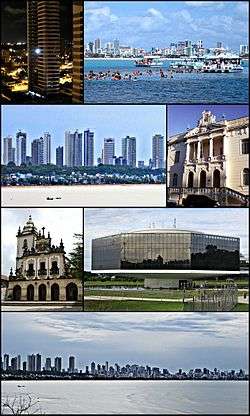 João Pessoa skyline | |||
| |||
|
Nickname(s): Sun Gate Green City | |||
| Motto(s): INTREPIDA AB ORIGINE | |||
 Location of João Pessoa in the state of Paraíba | |||
 João Pessoa Location of João Pessoa in Brazil | |||
| Coordinates: 07°05′00″S 34°50′00″W / 7.08333°S 34.83333°WCoordinates: 07°05′00″S 34°50′00″W / 7.08333°S 34.83333°W | |||
| Country | Brazil | ||
| Region | Northeast | ||
| State |
| ||
| Government | |||
| • Prefeito | Luciano Cartaxo (PSD) | ||
| Area | |||
| • Total | 211.475 km2 (81.651 sq mi) | ||
| Elevation | 40 m (130 ft) | ||
| Population (2010) | |||
| • Total | 801,718 | ||
| Time zone | UTC−3 (UTC−3) | ||
| Website | |||
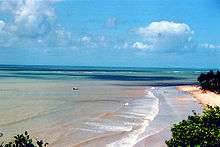
João Pessoa (Brazilian Portuguese: [ʒʊˈɐ̃w peˈsoɐ])[1] is the capital of the state of Paraíba in Brazil. It was founded in 1585 and it is also known as the city where the sun rises first, because it is the easternmost city in the Americas at 34° 47′ 38″ W, 7° 9′ 28″ S. Its easternmost point is known as Ponta do Seixas. The city is often referred as "the second greenest in the world", with more than 7 square kilometres (2.7 sq mi) of forested land, second only to Paris, France,[2] though such claim seems to be just a publicity stunt from the then mayor during Earth Summit.[3]
It is the state's largest city, with an estimated population of 801,718 of inhabitants.[4] Its metropolitan area comprises eight other satellite cities (Bayeux, Cabedelo, Conde, Lucena, Santa Rita, and others), totalling 1,223,000 of inhabitants.
The new "Estação Ciência, Cultura e Artes" (Science, Culture and Art Station),[5] located at the most eastern point of the Americas (Ponta das Seixas), is both an educational and cultural institution as well as a national landmark. The complex, inaugurated in 2008, was created by Brazilian architect Oscar Niemeyer and is one of his last projects.
The capital of Paraíba received in 2017 the title of creative city by UNESCO,[6] placing João Pessoa, as "Brazilian city of handicrafts". Besides the capital of Paraíba, just another city in Latin America, it has the same title, with the same category, which is Chordeleg, in Ecuador. The recognition of the capital João Pessoa, places it on the Brazilian tourist route for the richness of its popular art. This recognition had great contribution and influence, due to the mermaids project of Penha;[7] where women artisans perform the manual work, dialoguing with the design, fashion, creative economy, highlighting the art with fish scales in copper wires.
History
João Pessoa is the third oldest city in Brazil.[8] Previously named Frederikstadt by the Dutch and Parahyba by the Portuguese, the city was renamed for a governor of Paraíba state João Pessoa Cavalcanti de Albuquerque after his assassination in 1930.
Geography
Environment
João Pessoa has a 20 kilometres (12 mi) beachfront.[8]
João Pessoa has many green areas distributed among its avenues, parks, and residential neighborhoods, which support its claim as "the second greenest city in the world" with more than 7 square kilometres (2.7 sq mi) of forested land, second only to Paris. It was considered thus in 1992 after a survey of urban centres in various countries carried out by the United Nations (source: Embassy of Brazil in the UK).[9]
Climate
João Pessoa has a tropical monsoon climate (Köppen Am) with very warm temperatures all year long and strong rainfall in most of the months; however, October to December have a rather low rainfall.
| Climate data for João Pessoa (1961–1990) | |||||||||||||
|---|---|---|---|---|---|---|---|---|---|---|---|---|---|
| Month | Jan | Feb | Mar | Apr | May | Jun | Jul | Aug | Sep | Oct | Nov | Dec | Year |
| Record high °C (°F) | 32.8 (91) |
33.0 (91.4) |
33.6 (92.5) |
34.8 (94.6) |
32.0 (89.6) |
31.4 (88.5) |
30.2 (86.4) |
30.7 (87.3) |
32.0 (89.6) |
31.7 (89.1) |
32.0 (89.6) |
32.8 (91) |
34.8 (94.6) |
| Average high °C (°F) | 30.2 (86.4) |
30.5 (86.9) |
30.0 (86) |
29.8 (85.6) |
29.6 (85.3) |
28.3 (82.9) |
27.5 (81.5) |
27.8 (82) |
28.3 (82.9) |
29.3 (84.7) |
29.7 (85.5) |
30.0 (86) |
29.3 (84.7) |
| Daily mean °C (°F) | 27.1 (80.8) |
27.2 (81) |
27.0 (80.6) |
26.7 (80.1) |
26.0 (78.8) |
25.2 (77.4) |
24.2 (75.6) |
24.3 (75.7) |
25.1 (77.2) |
26.3 (79.3) |
26.7 (80.1) |
26.9 (80.4) |
26.1 (79) |
| Average low °C (°F) | 23.7 (74.7) |
23.5 (74.3) |
23.2 (73.8) |
22.8 (73) |
22.2 (72) |
21.4 (70.5) |
20.9 (69.6) |
20.5 (68.9) |
21.5 (70.7) |
23.0 (73.4) |
23.7 (74.7) |
23.9 (75) |
22.5 (72.5) |
| Record low °C (°F) | 19.6 (67.3) |
16.9 (62.4) |
19.0 (66.2) |
20.2 (68.4) |
19.6 (67.3) |
17.0 (62.6) |
17.0 (62.6) |
15.0 (59) |
13.6 (56.5) |
18.6 (65.5) |
17.8 (64) |
19.4 (66.9) |
13.6 (56.5) |
| Average rainfall mm (inches) | 75.8 (2.984) |
108.4 (4.268) |
252.2 (9.929) |
349.8 (13.772) |
307.3 (12.098) |
346.1 (13.626) |
346.2 (13.63) |
183.5 (7.224) |
87.2 (3.433) |
35.4 (1.394) |
24.9 (0.98) |
28.5 (1.122) |
2,145.4 (84.465) |
| Average rainy days (≥ 1 mm) | 8 | 9 | 15 | 17 | 17 | 18 | 21 | 16 | 11 | 7 | 5 | 5 | 149 |
| Average relative humidity (%) | 75 | 75 | 81 | 79 | 81 | 81 | 87 | 75 | 77 | 73 | 74 | 74 | 77.7 |
| Mean monthly sunshine hours | 244.2 | 219.1 | 206.9 | 181.5 | 193.9 | 180.7 | 190.5 | 230.1 | 235.1 | 266.2 | 272.7 | 274.2 | 2,695.1 |
| Source: Brazilian National Institute of Meteorology (INMET).[10][11][12][13][14][15][16][17][18] | |||||||||||||
Demographics
According to the IBGE of 2009, there were 801,718 people residing in the city. The racial makeup of the city was 45.72% White, 38.72% Pardo (two or more races), 2.77% Black, and 0.25% Asian or Amerindian.[19]
Religion
.jpg)
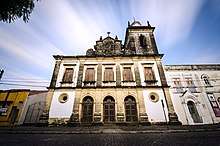
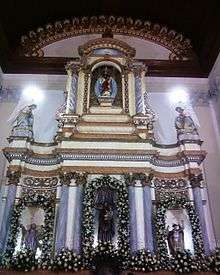
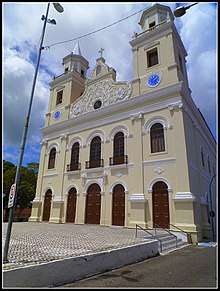
| Religion | Percentage | Number |
|---|---|---|
| Catholic | 74.06% | 442,841 |
| Protestant | 15.92% | 95,191 |
| No religion | 7.41% | 44,332 |
| Spiritist | 1.10% | 6,571 |

Transportation
International airport
Joao Pessoa is served by Presidente Castro Pinto International Airport.[21]
Rail System
The João Pessoa Urban Trains System is operated by diesel components in only one railway line with a 30 km extension spanning 4 municipalities, João Pessoa, Cabedelo, Bayeux and Santa Rita, constituted by the Cabedelo / stretch, with 10 stations in operation, carrying around 10.1 thousand passengers per day. Composed of three locomotives and 17 passenger cars, forming two compositions that carry out 28 daily trips; the passengers can enjoy a pleasant, safe, economical and fast trip, besides contemplating beautiful rural landscapes in the urban area.[22]
Economy
The GDP for the city was R$ 14,841,805 (2010).[23]
The per capita income for the city was R$ 19,284 (2010).[24]
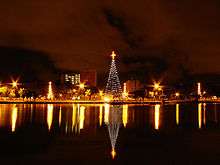
Sister cities



Culture
In the crafts part, the city stands out for its creativity through the popular art, possessing some places to be visited.
- "CREATIVE SPACE BARN":[28] The environment has an exhibition of pieces and works by more than 140 artisans and artists from Paraíba. The work of these artists can be visited by the public, who can also purchase the pieces.
- "THE PARAIBANIAN CRAFT MARKET":[29] The building has more than 120 shops that sell the region's handicrafts.
- "JÚLIO RAFAEL CRAFTS CENTER":[30] The place has 20 stores where are tradized handicraft products of different typologies, such as renaissance, embroidery, colored cotton, leather, weaving.
- "TAMBAÚ FAIRY":[31] The place has a large walk area where the shows and artistic and culture activities take place. The Fair is currently one of the main leisure options for visitors, tourists and residents of the capital. The Fair, has 45 boxes where the artisans sell their products and boxes where they sell typical foods of the Northeast.
- "SERENE OF THE PENHA":[32] The artisans who participate in the project produce biojóias with scales and fish leather.
Pieces produced: biojoias (necklaces, bracelets and earrings), flowers, handbags, garments, arrangements and bouquets. Raw material: Shells, pearls, copper wires, fishing net wires and fish scales. The Penha Serene, seeks to provide improvements in the quality of life of the families of those who participate. The artisans have the talent to transform objects into true works of art.[33]
- "HOUSE OF THE PEOPLE ARTIST":[34] In the House of the Popular Artist the craftsmen explore the variety of the crafts paraibano. In addition, the site houses the Craft Curatorship and spaces destined to the commercialization of the artisanal products and gastronomy of Paraíba. The collection consists of more than 1000 pieces that represent the genuine crafts of Paraíba, in 09 types: clay, wood, fibers, yarns, stones, metals, leather, indigenous handicrafts and recycled material. The space promotes the effective integration of the artisan activity with the tourist activity, contributing to the preservation of the manual arts that bring traces of the history, beliefs, customs and socio-cultural traditions of Paraíba.
Tourism
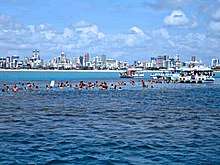
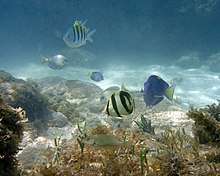
- Picãozinho:[35] It is one of the most important sights of the city. São Reef Formation, located about 1,500 meters from Tambaú beach, on the coast of João Pessoa.
- Natural Pools of Seixas Beach:[36] The Seixas Natural Pools, where we find hundreds of species of fish, seaweed, reptiles (sea turtles), mollusks, crustaceans and other marine organisms.
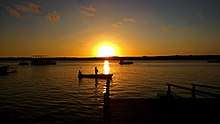
- Sunset on Jacaré beach:[37] Every day at 5:00 pm, when the sun begins to set, illuminating the waters of the Paraíba River, the saxophonist Jurandy do Sax, in a boat, performs the Ravel Bolero. At 6 pm another musician performs the 'Ave Maria'.

- Penha of Beach:[38] The name of this traditional beach derives from the symbol of one of the greatest religious events in Brazil: the Chapel of Our Lady of Penha. For more than 250 years, thousands of faithful have been accompanying the Penha Procession through the streets of João Pessoa.
- Beach of the Sun:[39] Between beautiful cliffs and the mouths of rivers and mangroves, there are reefs, corals, light waves and a fine stretch of white sand.
- Manaira Beach:[40] It is in the most economically developed neighborhood of Joao Pessoa. The sidewalk foot is commonly used for physical activities and well frequented by tourists and locals who enjoy the unique landscape.
- Beach Tambaú:[41] Synonymous with beauty and excitement, the sands of Praia de Tambaú are one of the busiest in Joao Pessoa. The various bars, restaurants and venues with live music are an additional attraction for those who want to enjoy one of the most beautiful beaches in the city. The handicraft market and the Tambaú Fair are a must stop for anyone visiting the neighborhood. The practice of diving is perfect for those who want to enjoy this paradise more closely.
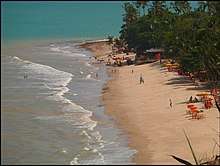
- Cabo Branco Beach:[42] Located in one of the noblest districts of the city, the beach, neighboring Tambaú, is part of the busiest area of the personal border. There are numerous restaurants, hotels, snack bars and residences that coexist harmoniously with the environment and make Cabo Branco one of the most sought after destinations in the city. From the barrier of Cabo Branco, where the Lighthouse of the same name is located, we have one of the most beautiful landscapes in Brazil.
- Bessa Beach:[43] In the extreme north of João Pessoa, with 5.3 km of white sands and beats, besides green and calm waters, reefs and coconut trees, beach Bessa is one of the most sought after by tourists.
- Caribessa : A few kilometers from the beach, in the middle of 4 km of preserved corals, the stretch without waves near the edge of Bessa, known by tourists and locals as "Caribessa" due to its beautiful calm waters, is rich in marine diversity, being a perfect environment for the preservation of the ecosystem. Whether via kayak or stand up paddle, anyone who visits the "Caribessa" is always in touch with the best of nature.
- Jacarapé Beach:[44] The native vegetation, the tranquility of the place and the soft sound of the weak waves breaking on the coast, make this part of the personal coast the perfect destination for your next trip.
- Gramame Bar Beach:[45] Beach more south of the coast of João Pessoa, Barra de Gramame is the scene of the encounter between the river and the sea. The formation of reefs in its extension guarantees a great tour to whoever visits it, even if it is an open sea beach. Dunes, mangroves and raft or kayak tours complement the experience of the visit.
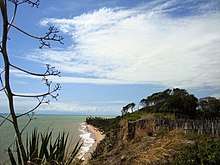
- Seixas Beach:[46] In this beach is the Eastern End of the Americas. Nationally known as the portion of land closest to the African continent, Praia do Seixas.
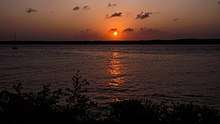
Museums

Source:[21]
- Museu Sacro e de Arte Popular, within the São Francisco church.
- Espaço Cultural José Lins do Rego. A cultural centre including history and science museums.
- City Museum. The former Casa da Pólvora, an old gunpowder store.
- Museu Fotográfico Walfredo Rodríguez.
- Bica Natural History Museum[47].
- Museum Foundation house of Jose Américo.[48]
- Hotel Globo Museum:[49] Formerly a luxury hotel in the city, it consists of two buildings of eclectic style, and its lines are influenced by Neo-classical, Art, Nouveau and Art Deco styles. Today it functions as a museum, where it houses the permanent exhibition of part of the furniture of the Hotel, in addition to a collection of popular art, is much visited for the appreciation of the beautiful view of the Sanhauá River and the sunset seen from its garden.

Sports
Stadiums
Soccer
João Pessoa provides visitors and residents with various sport activities.
American Football
Kayaking
Very Realized on Bessa beach, To reach the 4km of coral in the blue sea of the "Caribessa", tourists and practitioners can admire the beauties around it, kayaking will be a special reason to slowly enjoy every beautiful second that the nature of the city of João Pessoa offers[52].
Windsurfing
The practice of windsurfing on the beautiful beaches of the city of João Pessoa, yields an incredible experience in maximum contact with nature[53].
Sailing
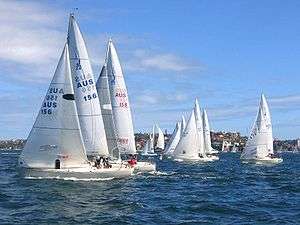
Realized in the Natural Pools of Seixas beach, on the most extreme eastern beach of the americas, where the sun rises first, the tourist contemplates the harmony between the blue of the sky and the green of the sea in the capital of Paraíba, and reveals fascinating scenarios[54].
Surfing
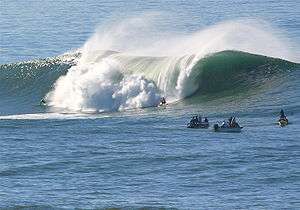
Cradle of great surfers with national prominence, the Paraíba has winning athletes in the most important disputes of the sport[55].
Standup paddleboarding
It is usually done on the beach of Bessa, in the quiet part known as caribessa, paddling on a surfboard, it is used on foot all that the sea can offer, and contemplated the beauties of one of the most beautiful sights of João Pessoa[56].
Diving
The coastline of João Pessoa, home to three of the most visited shipwrecks in the Northeast, are mainly sought after by nautical tourism enthusiasts and divers adventurers: Queimado, Alice and Alvarenga are considered of rare beauty and still maintain intact areas taken by algae and living beings from the bottom of the sea[57].
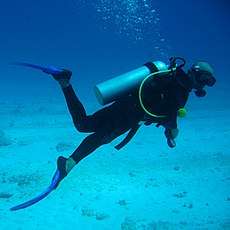
- Alvarenga Shipwreck : It is a type of vessel that was used to transport supplies to ships and wrecked 6 miles from the tip of Bessa's beach, 20 meters deep. It remains whole measuring 20 meters in length by 5 meters in the mouth. It is possible to penetrate the small bow and stern compartments safely. On the prow we can still see the winch that picked up the anchor. It is also common to find large stingrays and large shoals of fish, such as the top cock and the hook[58].
- Burnt Shipwreck : The Erie J.N.Y is an American steam of 2,000 tons. He had left Rio de Janeiro with 24,900 bags of coffee destined for the United States. On January 2, 1873, at 2 am, it caught fire and sank (so it was known as "Burned"). Passengers and crew were saved.
Today it is 17 meters deep, five miles from the tip of Bessa beach, in João Pessoa and its debris measures about 100 meters long by 15 meters wide (approximately 12 meters of mouth). There remains among the wrecks a large machine shaft that ends in a large propeller. The visibility of the water can reach 30 meters in the summer, but on average stays between 10 and 20 meters. It is the most visited by divers. It is considered the most significant shipwreck in the world, because it has its rectangular boilers and it is home to more than 50% of the marine species found in Paraíba[59].
- Wreck Alice: Alice is a Brazilian steam which was built in 1866 and measured 53 meters long by 6.6 meters. He was chartered by the government to transport Brazilian troops in the Paraguayan war. On March 30, 1869, Prince Emperor Gaston d'Orleans (Count d'Eu) took his place to take command of the Brazilian Army; Alice was shipwrecked in 1911.
Today it is 3.5 miles from the tip of Bessa beach and is 12 meters deep. The bow is its most entire part, 7.5 meters from the surface[60].
References
- ↑ The European Portuguese pronunciation is [ʒwɐ̃w pɨˈso.ɐ].
- ↑ "Onde o Sol brilha primeiro". Câmara Municipal de João Pessoa. Archived from the original on April 8, 2009. Retrieved March 2010. Check date values in:
|accessdate=(help) - ↑ "Cidade mais verde? Extremo oriental? Saiba o que é verdade sobre João Pessoa" (in Portuguese). G1.
- ↑ "Paraíba " João Pessoa". Instituto Brasileiro de Geografia e Estatística (IBGE). July 1, 2016. Retrieved November 26, 2016.
- ↑ ESTAÇÃO CIÊNCIA, CULTURA e ARTES (in Portuguese). joão pessoa, Brazil: E.C.C.A. 2006. ISBN 85-240-3919-1. Archived from the original (PDF) on December 24, 2007. Retrieved January 10, 2008.
- ↑ "Unesco Creative City title puts João Pessoa on the world tourist route through folk art". City Hall of João Pessoa. November 3, 2017. Retrieved August 29, 2018.
- ↑ "Mermaids from Penha". Secretary of Tourism of the Municipality of João Pessoa. Retrieved August 29, 2018.
- 1 2 "Introducing João Pessoa". Lonely Planet. Retrieved May 10, 2014.
- ↑ Green City (PDF). joão pessoa, Brazil: UK Embassy. 2006. ISBN 85-240-3919-1. Retrieved January 10, 2008.
- ↑ "Temperatura Média Compensada (°C)" (in Portuguese). Brazilian National Institute of Meteorology. 1961–1990. Archived from the original on May 5, 2014. Retrieved August 5, 2014.
- ↑ "Temperatura Máxima (°C)" (in Portuguese). Brazilian National Institute of Meteorology. 1961–1990. Archived from the original on May 5, 2014. Retrieved August 5, 2014.
- ↑ "Temperatura Mínima (°C)" (in Portuguese). Brazilian National Institute of Meteorology. 1961–1990. Archived from the original on May 5, 2014. Retrieved August 5, 2014.
- ↑ "Precipitação Acumulada Mensal e Anual (mm)" (in Portuguese). Brazilian National Institute of Meteorology. 1961–1990. Archived from the original on May 5, 2014. Retrieved August 5, 2014.
- ↑ "Número de Dias com Precipitação Mayor ou Igual a 1 mm (dias)". Brazilian National Institute of Meteorology. Archived from the original on May 5, 2014. Retrieved August 5, 2014.
- ↑ "Insolação Total (horas)". Brazilian National Institute of Meteorology. Archived from the original on May 5, 2014. Retrieved August 5, 2014.
- ↑ "Umidade Relativa do Ar Média Compensada (%)". Brazilian National Institute of Meteorology. Archived from the original on May 5, 2014. Retrieved August 5, 2014.
- ↑ "Temperatura Máxima Absoluta (ºC)". Brazilian National Institute of Meteorology (Inmet). Retrieved August 5, 2014.
- ↑ "Temperatura Mínima Absoluta (ºC)". Brazilian National Institute of Meteorology (Inmet). Retrieved August 5, 2014.
- ↑ Síntese de Indicadores Sociais 2000 (PDF) (in Portuguese). João Pessoa, Brazil: IBGE. 2000. ISBN 85-240-3919-1. Retrieved January 31, 2009.
- ↑ Religion in João Pessoa by IBGE
- 1 2 "João Pessoa in Brazil". Footprint Travel Guides. Retrieved March 29, 2015.
- ↑ "João Pessoa". CBTU-Brazilian company of urban trains. Retrieved August 29, 2018.
- ↑ GDP (PDF) (in Portuguese). João Pessoa, Brazil: IBGE. 2005. ISBN 85-240-3919-1. Archived from the original (PDF) on October 2, 2008. Retrieved July 18, 2007.
- ↑ per capita income (PDF) (in Portuguese). João Pessoa, Brazil: IBGE. 2005. ISBN 85-240-3919-1. Archived from the original (PDF) on October 2, 2008. Retrieved July 18, 2007.
- ↑ "MUNICIPALITY OF JOÃO PESSOA". cidade-brasil. Retrieved September 5, 2018.
- ↑ Mônica Melo (August 31, 2017). "Secretariat confirms tourist cooperation between João Pessoa and US city". MUNICIPAL CITY OF JOÃO PESSOA. Retrieved September 5, 2018.
- ↑ "Cities-Sisters – João Pessoa and Pompano Beach". Gazeta News. March 24, 2014. Retrieved September 5, 2018.
- ↑ "CREATIVE SPACE BARN". Secretary of Tourism of the Municipality of João Pessoa. Retrieved August 30, 2018.
- ↑ "THE PARAIBANIAN CRAFT MARKET". Secretary of Tourism of the Municipality of João Pessoa. Retrieved August 30, 2018.
- ↑ "JÚLIO RAFAEL CRAFTS CENTER". Secretary of Tourism of the Municipality of João Pessoa. Retrieved August 30, 2018.
- ↑ "TAMBAÚ FAIRY". Secretary of Tourism of the Municipality of João Pessoa. Retrieved August 30, 2018.
- ↑ "SERENE OF THE PENHA". Secretary of Tourism of the Municipality of João Pessoa. Retrieved August 30, 2018.
- ↑ "Sereias da Penha". Paraíba Criativa. Retrieved August 30, 2018.
- ↑ "Museum Popular Artist's House". Paraiba Criativa. Retrieved August 29, 2018.
- ↑ "PICÃOZINHO". Secretary of Tourism of the Municipality of João Pessoa. Retrieved September 5, 2018.
- ↑ "SEIXAS NATURAL SWIMMING POOLS". Secretary of Tourism of the Municipality of João Pessoa. Retrieved September 5, 2018.
- ↑ "PÔR DO SOL DO JACARÉ". Secretary of Tourism of the Municipality of João Pessoa. Retrieved September 5, 2018.
- ↑ "Penha Beach". Secretary of Tourism of the Municipality of João Pessoa. Retrieved September 5, 2018.
- ↑ "Beach of the Sun". Secretary of Tourism of the Municipality of João Pessoa. Retrieved September 5, 2018.
- ↑ "MANAIR BEACH". Secretary of Tourism of the Municipality of João Pessoa. Retrieved September 5, 2018.
- ↑ "Beach Tambaú". Secretary of Tourism of the Municipality of João Pessoa. Retrieved September 5, 2018.
- ↑ "CAPE WHITE BEACH". Secretary of Tourism of the Municipality of João Pessoa. Retrieved September 5, 2018.
- ↑ "Beach Bessa". Secretary of Tourism of the Municipality of João Pessoa. Retrieved September 5, 2018.
- ↑ "JACARAPÉ BEACH". Secretary of Tourism of the Municipality of João Pessoa. Retrieved September 5, 2018.
- ↑ "GRAMAME BAR BEACH". Secretary of Tourism of the Municipality of João Pessoa. Retrieved September 5, 2018.
- ↑ "Seixas Beach". Secretary of Tourism of the Municipality of João Pessoa. Retrieved September 5, 2018.
- ↑ Bica Natural History Museum
- ↑ Museum Foundation house of Jose Américo
- ↑ "Hotel Globo". Paraiba Criativa. Retrieved August 30, 2018.
- ↑ Hévilla Wanderley (January 2, 2017). "10 years of Espectros: review in photos the decade of the best team in the Northeast". Globo Esporte. Retrieved September 5, 2018.
- ↑ Hévilla Wanderley (January 4, 2017). "10 anos de Espectros: passeie pela história do time a partir de seus vultos". Globo Esporte. Retrieved September 5, 2018.
- ↑ "Caiaque". Secretary of Tourism of the Municipality of João Pessoa. Retrieved October 2, 2018.
- ↑ "windsurf". Secretary of Tourism of the Municipality of João Pessoa. Retrieved October 2, 2018.
- ↑ "VELA". Secretary of Tourism of the Municipality of João Pessoa. Retrieved October 2, 2018.
- ↑ "SURF". Secretary of Tourism of the Municipality of João Pessoa. Retrieved October 2, 2018.
- ↑ "stand up paddle". Secretary of Tourism of the Municipality of João Pessoa. Retrieved October 2, 2018.
- ↑ "mergulho". Secretary of Tourism of the Municipality of João Pessoa. Retrieved October 2, 2018.
- ↑ "Naufrágio Alvarenga". Secretary of Tourism of the Municipality of João Pessoa. Retrieved October 2, 2018.
- ↑ "Naufrágio Queimado". Secretary of Tourism of the Municipality of João Pessoa. Retrieved October 2, 2018.
- ↑ "Naufrágio Alice". Secretary of Tourism of the Municipality of João Pessoa. Retrieved October 2, 2018.
External links

- Official Promotional video of João Pessoa | English


